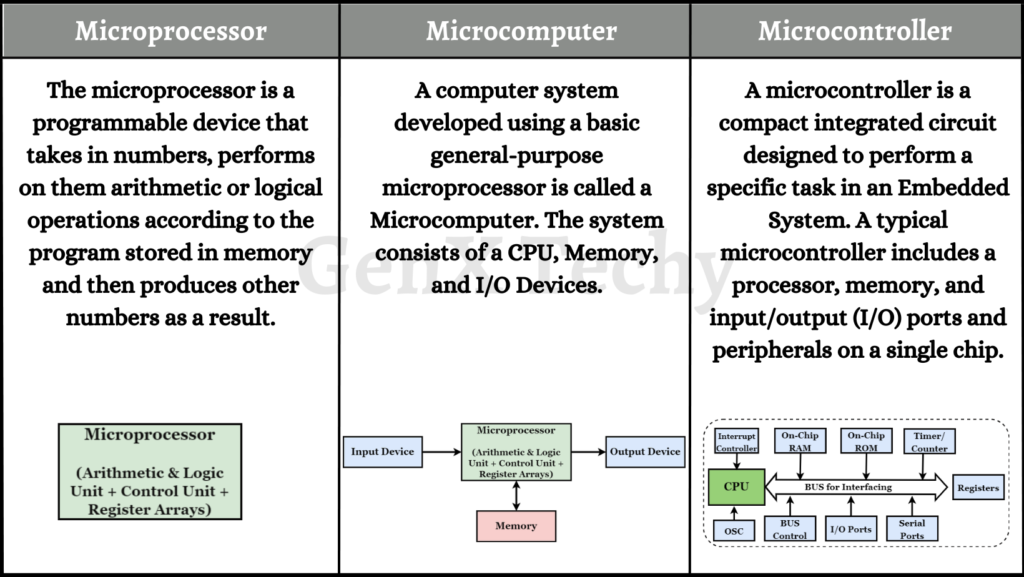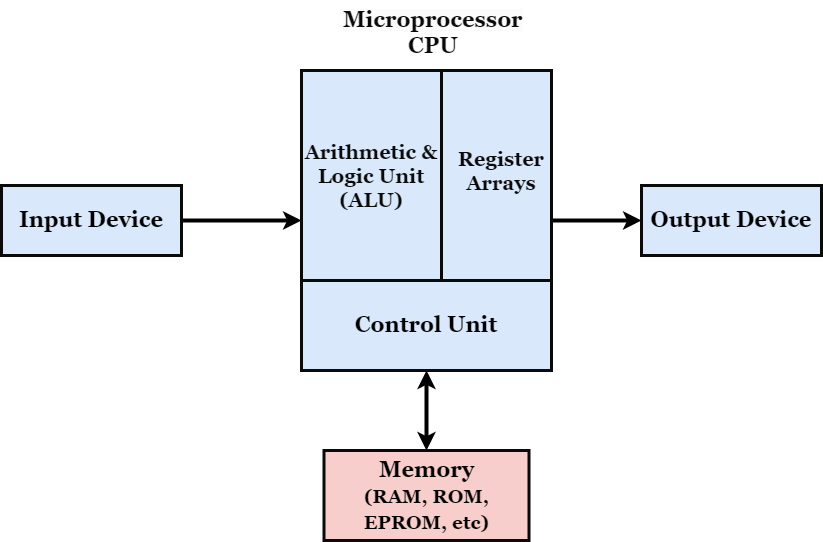Microprocessors: Fundamentals
What is a Microprocessor?
- A microprocessor is a compact digital device integrated on a single chip. It is capable of retrieving instructions from a memory source, decoding and executing them. Microprocessor involves in performing various arithmetic and logical operations. Furthermore, it can accept data from input devices and transmit results to output devices. When a microprocessor is connected to memory, input and output devices, it forms the fundamental building block of a microcomputer.
- In recent times, microprocessors have achieved widespread presence across a diverse array of electronic devices. These versatile chips can now be found in various equipment such as mobile phones, printers, washing machines, and numerous others. Microprocessors find application in advanced domains such as radars, satellites, and aviation systems. Their presence is now a common feature across diverse consumer electronics and appliances. The electronic industry’s progress and device integration have led to cost reductions and broader microprocessor applications, making them prevalent and versatile.
Difference between Microprocessor, Microcomputer and Microcontroller
Figure 1 detailed the differences between a Microprocessor, a Microcomputer and a Microcontroller.

Fig: 1: Comparison among Microprocessor, Microcomputer and Microcontroller
A Microprocessor-based System
There are five building blocks of a microprocessor-based system namely:
- Input Unit
- Arithmetic and Logical Unit (ALU)
- Control Unit
- Memory Unit
- Output Unit
Let us discuss each building block elaborately.
1. Input Unit:
i) The input unit in a microprocessor-based system has a vital role in receiving and processing data and instructions from external sources. It allows the microprocessor to interact with the external world and gather input for further processing.
ii) Keyboards, mouse, touchscreens, scanners, sensors, and several other data-collecting devices are examples of common input devices connected to the input unit.
iii) The input unit converts the received input into a format that the microprocessor can understand and process, enabling the system to respond accordingly based on the input received.
2. Arithmetic and Logical Unit (ALU):
i) ALU (Arithmetic and Logical Unit) is an essential part of a microprocessor-based system that carries out arithmetic and logical operations.
ii) It performs mathematical calculations, such as addition and multiplication, as well as logical evaluations, including comparisons and Boolean logic.
iii) The ALU operates on binary data and can also handle shifting, rotating, and bitwise operations. It is crucial for executing instructions and manipulating data within the microprocessor.
3. Control Unit:
i) The Control Unit is an important component of a microprocessor that manages and coordinates the execution of instructions. It is responsible for fetching instructions from memory, decoding them, and directing the flow of data within the microprocessor.
ii) The Control Unit ensures that each instruction is executed in the correct sequence and controls the activation of other microprocessor components, such as the Arithmetic and Logical Unit (ALU) and registers. It generates control signals to coordinate data movement, perform necessary operations, and manage the overall operation of the microprocessor.
iii) The Control Unit interprets the instructions and sends control signals to the appropriate components, enabling them to carry out the required operations. It also manages the interaction between the microprocessor and external devices, coordinating input and output operations.
4. Memory Unit:
i) The memory unit in a microprocessor is responsible for storing and retrieving data and instructions. It serves as the primary storage location for both program instructions and data during the execution of a program.
ii) The memory unit is typically divided into two types:
a) Instruction Memory: This is where the microprocessor fetches instructions for execution. It holds the program instructions that dictate the operations to be performed.
b) Data Memory: This is where data is stored, including variables, constants, and intermediate results generated during program execution.
iii) The memory unit is organized into addressable locations, each holding a fixed amount of data or instruction. The microprocessor uses memory addresses to access specific locations within the memory unit.
iv) The memory unit interacts with other components of the microprocessor, such as the Control Unit and the Arithmetic and Logical Unit (ALU), to read instructions, retrieve data, and store results.
5. Output Unit:
i) The output unit in a microprocessor-based system is responsible for presenting processed data or information to external devices or users. It converts the digital output generated by the microprocessor into a format that can be easily understood or utilized by humans or other devices.
ii) The output unit interfaces with various output devices such as displays, printers, speakers, or actuators, depending on the specific application. It takes the processed data or results from the microprocessor and sends them to the appropriate output device for presentation or further processing.
iii) The output unit receives signals from the microprocessor or other components, converts them into suitable formats, and transmits them to the connected output devices. It may include features like digital-to-analog converters, signal conditioning circuits, or amplifiers to ensure compatibility and proper functioning with different types of output devices.
In a computer system ALU, Register Arrays and Control Unit are combined in one unit called Central Processing Unit (CPU). The block diagram of a computer is shown in figure 2.

Fig. 2: A Microprocessor-based System
